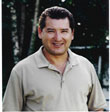High Jumps:
 A
General Workout for High Jumpers
A
General Workout for High Jumpers
Article By: Coach, George Payan
The following recommendations
are from an Olympic High Jumper, Doug Nordquist.
High
Jump Developing an awareness of the Arch
Article By Peter Brewer
Body awareness
in the air is not always an intuitive talent. Many new jumpers
have only a raw sense of where the bar is, and do not have any
early facility in arching over it, or maintaining a layout position
long enough for a clearance. This feel for where the cross bar
is, is often delayed by the beginning jumper discomfort at being
in the layout position to begin with. This initial paranoia about
being backwards and not seeing the mat (which some new jumpers
swear is as disconcerting as being upside down) often leads the
rookie jumpers to do the single greatest in-air mistake: bringing
the chin down to the chest to get a “head's up” orientation in
the air.
Squeeze the "J"
from the Beginning high Jumpers
Article By Peter Brewer:
One of the
hardest problems to correct for beginners is the lack of pit penetration.
The jumper is higher than the bar, but fails to carry enough momentum
into the pit and comes down on the bar. The leading cause of this
flaw is that the beginning jumper instinctively feels comfortable
with an approach that brings him or her close to the bar and thus
results in a narrow take-off angle (the angle between the direction
the body is moving at takeoff and the cross bar). The narrower
of this angle the jumper will fail to move past the bar into the
pit and the jumper will dislodge the bar even though adequate
height may have been achieved. What to do?
 An
Argument for Fundamentals in the Flop High Jump
An
Argument for Fundamentals in the Flop High Jump
Article By Jim Kiefer:
Men's head Coach, Fullerton College
After reviewing several
articles on the mechanics and techniques employed in the development
of high jumpers, one primary trend became evident. It is not uncommon
for writers (especially coaches) who are writing and describing
the principles of training for the flop high jump to conclude
that the practices of a gifted athlete (his/her behaviors) explain
the proper or correct variables and absolutes for everyone participating
in the event to model themselves after.
Horizontal Jumps:
Understanding and Coaching
Individual Long Jump Components
Article By: Ed Jacoby
It must be remembered
that although these objectives are individual, they must be grouped
into a whole and they generally are contingent upon each other.
When one of these components change, look for the others to change
too. A common rule is: If there is a problem with one portion
of the jump, it is usually the result of the preceding phase.
Teaching
The Triple Jump
Article By Douglas Todd: Director, Cross Country and Track and
Field
Mt. San Antonio College (Mt. SAC)
Important
to the development of any triple jumper is an understanding of
the 'feel' or rhythm of the event. The athlete must clearly understand
how the event flows from one segment to the next when done correctly.
Because of this need to understand, it becomes crucial that the
coach begin instruction with a whole-part-whole teaching philosophy.
The novice triple jump athlete must develop the kinesthetic awareness
of the whole movement before instruction progresses to the individual
parts. Without knowledge of the whole, the individual parts are
meaningless.
Sample Long & Triple Jumper's Workout
Article By Ed Luna: UC Riverside Coach, AAF/CIF Instructor
This is a
workout sheet that can be printed and used as an outline for Long
and Triple jump training.
HORIZONTAL JUMPS, Part
I The Basics and Long
Jump
Article By Ed Luna: UC Riverside Coach, AAF/CIF Instructor
I will be
the first to tell you that never in my dreams did I ever think
that I would be sitting in front of a computer writing to my coaching
peers about the art of training horizontal jumpers. In my competitive
days, I was a thrower and was given the head track job because
nobody else wanted it. I was young, energetic, and stupid. During
my search for assistant coaches, I was able to cover all areas
except the jumps. Being the head coach, I appointed myself; I
had to educate myself on these events quickly. I purchased every
book, magazine, and video available. I attended every clinic and
seminar, and talked to every coach in the Western Hemisphere.
Then, I searched our campus for anybody that would listen and
who I could persuade to try coming out for the track team.
HORIZONTAL JUMPS,
Part II The Triple Jump
Article By Ed Luna: UC Riverside Coach, AAF/CIF Instructor
The Triple
Jump requires speed, power, rhythm, balance, flexibility, concentration,
and body awareness. The triple jump has been referred to as "POWER
BALLET."
It is best to start
out with the basic movements by having your athletes Hop, then
Step, then Jump from a standing start. The take-off foot should
be the athlete's strongest leg due to the fact it will be used
for the Hop and the Step, or determined by the athlete's preference.
The jumper should concentrate on an even rhythm for each landing.
The foot strike of the Hop an Step should be flat or full-footed,
with the landing leg knee bent slightly in preparation for take-off.
![]()




